As the world’s second largest coffee exporting power after Brazil, it is no surprise that the Vietnamese coffee market owns one of the richest and most diverse coffee cultures. From rich pure coffee beans, convenient instant coffee packages to sophisticated hand-roasted products. The Vietnamese coffee market is always vibrant and full of choices. And if you are looking for a product that suits your taste among countless choices, please refer to the following article to discover the best Vietnamese coffee beans, the best Vietnamese instant coffee, and the best Vietnamese ground coffee to find the perfect coffee flavor suitable for you.
Global Coffee Bean Market
According to a 2024 report by Grand View Research, the global coffee bean market was valued at approximately $32.6 billion in 2023 and is projected to expand to $55 billion by 2030, with an estimated compound annual growth rate (CAGR) of 7.9% from 2024 to 2030.
By type, Arabica beans dominated the market, accounting for about 59.8% of the market share in 2023, thanks to their mild flavor, gentle acidity, and lower caffeine content. Meanwhile, Robusta beans are expected to grow faster (at a CAGR of around 8.6%) due to their high yield, ease of cultivation, and widespread use in instant coffee production.
Regionally, Europe led the market with about 34.8% of the revenue, reflecting its long-standing coffee consumption culture. However, the Asia-Pacific region is emerging as the fastest-growing area (with a CAGR of nearly 10%), driven by the growing popularity of modern coffee shops and the shift from tea to coffee in countries like China and India.
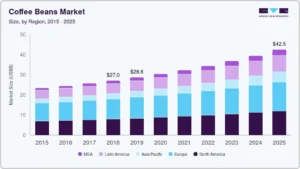
Robusta Coffee Beans
Robusta coffee accounts for around 40% of the world’s coffee production. Among producing countries, Vietnam is the world’s largest exporter of Robusta beans, followed by Brazil, India, Malaysia, Indonesia, and others.
Characteristics of Robusta Coffee Beans
In terms of shape, Robusta beans are round, with a deep, straight crease in the middle. They measure about 10–13 mm in diameter. The beans are dark brown and contain 3–4% caffeine, while Arabica contains only 1–2%.

Flavor Profile of Pure Robusta Coffee
Pure Robusta coffee is favored for its bold taste and distinctive aroma. Generally, Robusta is much more bitter and astringent than Arabica. One reason behind this is that Robusta is often processed using the dry method.
Additionally, Robusta beans contain a high amount of Chlorogenic Acid (CGA). Despite being called an “acid,” CGA is not associated with sourness but bitterness. During roasting, CGA breaks down into caffeic acid and quinic acid, which, when combined with caffeine, create the typical bitterness of Robusta. Thus, even though Robusta contains nearly twice as much chlorogenic acid (CGA) as Arabica, it does not taste sour, but rather more bitter.
Furthermore, Robusta contains nearly twice the caffeine of Arabica, which is why blending the two varieties often results in a balanced product loved by many. This is why many Italian coffees (Espresso) contain 10–15% Robusta, to enhance aroma and create a thicker crema.
With its high caffeine content, Robusta delivers a bold and intense taste that not only boosts alertness but can also increase heart rate and blood pressure. It is characterized by its bitterness, nutty notes, and strong aroma.
Growing conditions
Robusta coffee grows well in areas with lots of rain and lots of sunlight. The suitable temperature for growing Robusta coffee beans is 24 – 29 degrees Celsius. Coffee trees live in areas with altitudes below 1000 meters, commonly at 850 – 900 meters, and in areas with fertile red basalt soil.
In Vietnam, there are many regions suitable for growing Robusta, especially Buon Ma Thuot, Dak Lak, Lam Dong, Gia Lai, Dak Nong, etc. However, due to differences in soil, the flavor and aroma of Robusta beans in different regions are also relatively different.
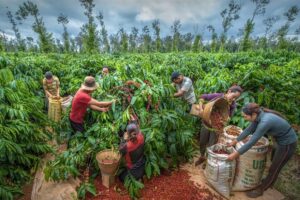
Arabica Coffee Beans
With its light acidity, floral and honey-like aroma, Arabica is known as the “queen” of the coffee world. Arabica beans, also called “cà phê chè” in Vietnam, originated in Ethiopia and are celebrated for their fragrant, sweet, and smooth taste, representing 60–70% of global coffee production. Arabica is highly sought after internationally, particularly in Western countries.
The origins of Arabica trace back to southwestern Ethiopia in Africa. During the 17th–18th centuries, Arabica varieties spread globally: Typica was taken by the Dutch from Yemen to Batavia, the Netherlands, and Central and South America, while Bourbon spread to Bourbon Island (Réunion), France, and Africa. Arabica was introduced to Vietnam in the 19th century by a French missionary.
Characteristics of Arabica Coffee Beans
Arabica beans are larger and more elongated than Robusta, with an S-shaped crease in the middle. They contain only 1–2% caffeine.

Flavor Profile of Pure Arabica Coffee
Arabica contains 15–17% oils and 6–9% sugars, much higher than Robusta. This is why Arabica coffee tastes sweeter, smoother, and more layered in flavor. When roasted, these sugars caramelize and release subtle acidity, even though Arabica actually contains less acid than Robusta.
Experts describe Arabica as having a light, crisp acidity, mild bitterness, and unique sweetness. It also carries diverse flavor notes such as floral, nutty, chocolate, fruity, and citrus tones, offering complex and distinct tasting experiences.
Arabica is often considered the most complex and refined coffee, with varying profiles depending on its terroir. For instance, Central and South American Arabica is known for its chocolatey richness, while African Arabica is famous for its floral, fruity brightness.
Overall, Arabica is ideal for those who prefer smooth, mildly sweet coffee, enjoyable either black or with milk and sugar.
Growing Conditions
Arabica is typically grown at altitudes of 800 meters or higher, in cool climates with temperatures of 15–24°C and annual rainfall of 1200–2200 mm. The plant thrives in highland areas, with small canopies and oval-shaped leaves, and is relatively frost-tolerant. Arabica trees can be harvested after 3–4 years of growth.
Robusta coffee growing areas in Vietnam
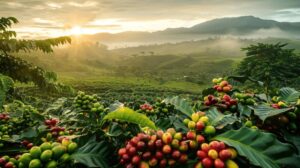
Best Instant Vietnamese Coffee
Instant coffee is the perfect choice for busy individuals who still want to enjoy a rich, full-flavored cup of coffee. As one of the world’s largest coffee exporters, Vietnam’s instant coffee market is incredibly diverse, with numerous brands and distinct flavors. Below are some of the leading coffee brands you can consider:
Comparison Table of Top Instant Coffee Brands:
| Brand | Signature Product | Flavor Profile | Best Suited For |
| Trung Nguyen Legend | G7 3in1 | Bold, sweet, and creamy with a strong coffee aroma. | People who prefer a bold, sweet milk coffee and need a quick energy boost. |
| Vinacafé | Gold Original 3in1 | Mild sweetness with a harmonious aroma of coffee and milk. | Those who favor a gentle, not-too-bitter taste. |
| Highlands Coffee | 3in1 | A balanced blend of coffee and milk, with a distinctive aroma. | People looking for the familiar, sophisticated taste of a coffee chain. |
| King Coffee | 3in1 | A bold flavor from Buon Ma Thuot coffee beans and a captivating aroma. | Individuals who prefer a strong, traditional coffee taste. |
| Nescafé | 3in1 Đậm Đà Hài Hòa (Bold and Harmonious) | A distinctive roasted coffee flavor, balanced between bitterness and sweetness. | Those who like a balanced, easy-to-drink coffee. |
| Wake-Up | 2in1 (Coffee & Sugar) | A strong black coffee flavor, with less sweetness. | People who enjoy iced black coffee and need a powerful kick to stay awake. |
Best Vietnamese Ground Coffee
Pre-ground coffee is the ideal choice for those who love the traditional Vietnamese phin brewing method but don’t have the time to grind beans. It provides the authentic flavor of pure coffee without the added sugar of instant blends. If you’re seeking a bold, aromatic cup of coffee, ground coffee is the way to go. Here are some of the best ground coffee brands to try:
Trung Nguyên Coffee
Trung Nguyên is one of Vietnam’s most popular and beloved coffee brands, associated with the slogan “Inspiring Creativity.” Its ground coffee products are not only popular domestically but also exported worldwide.
Signature Products:
- Sáng Tạo 8: A refined blend of Arabica and Robusta, offering balanced, bold yet smooth flavor with lingering aroma and pleasant aftertaste. Suitable for both beginners and coffee connoisseurs.
- Chinh Phục: A diverse product line with various roast levels (from medium to dark) and blending ratios, making it easy for users to find their preference. Suitable for both traditional phin brewing and espresso machines.
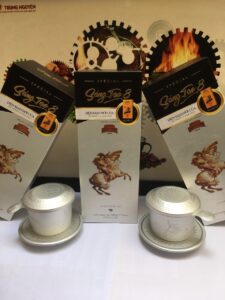
Highlands Coffee
Originating from its famous coffeehouse chain, Highlands Coffee also provides packaged ground coffee for at-home enjoyment. Its strength lies in its familiar, consistent, and accessible flavor profile.
Signature Products:
- Moka: A unique blend of Robusta, Culi, Moka, and Arabica. Strong flavor with delicate aroma, ideal for traditional phin brewing.
- Culi: Known for its intense bitterness, thick aftertaste, and captivating aroma. Perfect for those who love bold, adventurous coffee.

K7 CAPHE
K7 CAPHE was born from the quiet moments amidst the busy pace of modern life, when all one needs is a “real” cup of coffee to regain balance. The brand aims to connect Vietnam’s coffee heritage with a contemporary lifestyle, using advanced freeze-drying technology to preserve pure and refined flavors. K7 CAPHE is more than just instant coffee; it is a complete experience for the modern soul—slowing down, being authentic, and being profound.
Signature Products:
- Original Freeze-Dried Coffee: This is a premium freeze-dried coffee packed in 30g sachets (15 sticks per box), making it portable, pure, and easy to prepare. There is no sugar or preservatives, and it can be used for both hot and cold drinks. The flavor profile is bold yet smooth, with earthy and slightly spicy undertones, creating a balanced harmony between the depth of Arabica and the strength of Robusta. It is ideal for minimalists, travelers, and creative minds who appreciate a “classic” coffee with a modern, refined edge.
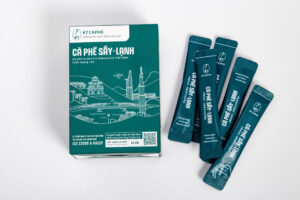
Secrets to Choosing and Brewing Vietnamese Coffee Perfectly
For true coffee lovers, enjoying a pure cup of coffee is not just a habit but an art. The secret begins with knowing how to recognize pure coffee.
Pure coffee, when brewed, has a transparent chestnut-brown color, not overly thick or syrupy. Clean coffee powder is light and airy, floating on water rather than sinking like adulterated coffee. This is the first sign to identify genuine coffee.
And to fully savor its flavors, the phin brewing method plays a crucial role:
- Rinse the filter with boiling water to warm it up and remove dust, allowing better extraction.
- Put about 20 – 25g of ground coffee into the phin, shake lightly to spread evenly.
- Slowly pour 30ml of boiling water over the grounds, let sit for 2–3 minutes to allow the coffee to expand and release its aroma.
- Place the press gently on top, then add 50–60ml of boiling water, cover, and let the coffee drip slowly, creating a smooth, rich cup.
- Once finished, drink it black, or add sugar, condensed milk, or ice to suit your taste.
Expert Tip: For stronger crema, try blending 20% Robusta with 80% Arabica — a classic Italian espresso ratio.
The solution for convenience and guaranteed taste
When you are too frustrated in choosing the right coffee for yourself, K7 CAPHE offers a perfect answer. Thanks to the breakthrough freeze-drying technology, the brand has kept the rich, pure flavor of 100% Vietnamese coffee beans in each convenient small package. Now, there will be no need to trade off between quality and time, because in just 30 seconds, you will have an original cup of coffee, no sugar, no additives. K7 CAPHE is the smart choice to enjoy the authentic flavor in the easiest way, anywhere.
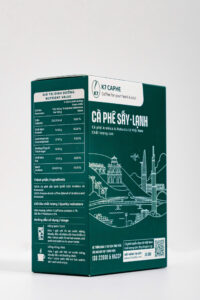
Each drop of Vietnamese drip coffee falls slowly, capturing the essence of flavor and the refinement of a unique coffee art. Vietnamese coffee is not only diverse in bean varieties but also rich in preparation methods, from the bold strength of Robusta, the delicate touch of Arabica, to the convenience of instant coffee and the craftsmanship of hand-roasted blends. Depending on your needs and taste, you can choose the type of coffee that suits you best. More than just a drink, every cup of Vietnamese coffee represents a culture, a source of national pride shared with the world.
